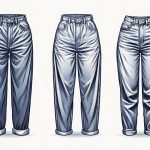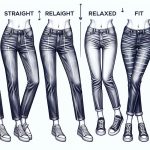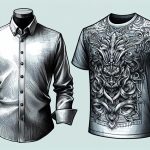When you think about repurposing old clothes, you're not just giving your wardrobe a fresh look; you're also taking a step toward sustainability. Start by evaluating your wardrobe, categorizing items based on their potential for upcycling, and considering fabric quality and fit. You might find that a simple t-shirt can be transformed into a chic crop top or a pair of jeans can become a stylish patchwork piece. But there's more to uncover beyond these basics. How can you creatively combine fabrics or add unique embellishments to make your pieces truly one-of-a-kind? Let's explore further.
Table of Contents
Key Takeaways
- Transform old t-shirts into trendy crop tops, no-sew tote bags, or fringe designs for a fresh look.
- Patch and distress denim to create modern, stylish jeans or convert them into skirts and pouches.
- Use vintage buttons and fabric scraps for unique embellishments, adding a nostalgic touch to garments.
- Convert dresses into skirts with simple cutting and hemming techniques, creating new wardrobe pieces.
- Repurpose fabric scraps into accessories like jewelry, belts, and hats for personalized style enhancements.
Assessing Your Wardrobe
Start by pulling out all your old clothes and evaluating their condition and potential for upcycling. This wardrobe assessment is essential in identifying pieces that can be transformed into something new and stylish.
Lay everything out and sort them into categories: keep, upcycle, donate, and discard. Pay close attention to the fabric quality, current fit, and any damage that might be too extensive to repair.
Don't be afraid to be ruthless in this clothing purge. Holding onto items you'll never wear again only clutters your space and mind. Examine each piece and ask yourself if it sparks joy or has the potential to be altered into something you'll love.
A simple hem adjustment or adding embellishments can breathe new life into an old garment.
As you go through this process, think about your current style and what's missing from your wardrobe. Could an outdated dress be turned into a trendy top? What about transforming those worn-out jeans into chic shorts?
With each decision, envision the possibilities and trust your creativity. This thorough approach ensures that your upcycled wardrobe will be both functional and fashionable, aligning perfectly with your aspirations for mastery in sustainable fashion.
Easy T-Shirt Transformations
Transforming old T-shirts can be incredibly fun and simple.
You can turn them into stylish crop tops, no-sew tote bags, or even trendy fringe designs.
Let's explore how you can give your tired tees a fresh, new look.
Stylish Crop Tops
With just a few simple cuts and knots, you can turn an old t-shirt into a trendy crop top. This transformation isn't only stylish but also a great way to breathe new life into your wardrobe. To master this DIY project, follow these steps:
- Mark your cut lines: Use a fabric marker to outline where you want to cut the shirt. Remember, you can always trim more but can't add fabric back.
- Cut the shirt: Carefully cut along the lines. For a basic crop, cut the bottom of the shirt to your desired length and trim the sleeves for a sleeker look.
- Add embellishments: Turn your crop top into a DIY embellished top by sewing on patches, beads, or fabric paint designs.
- Experiment with knots and layers: For a chic twist, cut the back of the shirt into strips and knot them. Pair your crop top with high-waisted jeans or layer it over a tank top to mix and match textures.
These crop top styling techniques will elevate your outfit, making it versatile for various occasions. By mastering these easy t-shirt transformations, you'll have a unique piece that showcases your creativity and fashion sense.
No-Sew Tote Bags
Repurposing an old t-shirt into a no-sew tote bag is another fantastic way to upcycle your wardrobe while creating something practical and stylish. Begin by selecting a t-shirt with a design or color you love. Lay it flat and cut off the sleeves and neckline to form the bag's opening.
Next, cut slits along the bottom hem, about one inch apart and four inches up. Tie the corresponding front and back slits together in knots to close the bottom of your tote.
Now, let's elevate your creation with fabric painting techniques. Use stencils and fabric paint to add unique designs, patterns, or even your initials. For added flair, incorporate DIY bag embellishments such as buttons, patches, or beads. This not only personalizes your bag but also gives it a polished look.
If you prefer other no-sew purse designs, consider variations like upcycled handbags made from other materials in your closet. The beauty of these projects is their simplicity and the opportunity to express your creativity.
With just a few steps, you'll transform an old t-shirt into a chic, functional tote that stands out. Happy crafting!
Trendy Fringe Designs
Turn an old t-shirt into a trendy fringe top by simply cutting strategic slits and knots. This technique isn't only easy but also incredibly stylish, allowing you to infuse new life into your wardrobe. Here's how to master this transformation:
- Mark the Fringe Lines:
Lay your t-shirt flat and use a ruler and chalk to draw evenly spaced horizontal lines from the bottom hem to about midway up the shirt.
- Cut the Fringe:
Carefully cut along the lines, making sure each strip is about the same width. Precision here guarantees a more polished look.
- Knot the Fringe:
Tie a simple knot at the end of each fringe strip. For added detail, you can double-knot or even braid small sections.
- Accessorize:
Pair your new fringe top with fringe earrings or a DIY belt to complete the ensemble.
Denim Redesign Ideas
Transform your old jeans into stylish and functional new pieces with these creative denim redesign ideas. Start by embracing the art of denim patchwork. This technique not only repairs worn-out areas but also adds a unique, artisanal touch to your jeans. Cut out patches from other denim scraps or even contrasting fabrics, and sew them onto your jeans. The result is a visually appealing, textured look that's both trendy and resourceful.
Next, consider distressed denim to give your old jeans a modern edge. Use sandpaper, a cheese grater, or even a razor blade to create frayed edges and small rips in the fabric. Be strategic about the placement to ensure the distressing looks natural and stylish. This method breathes new life into your jeans, making them perfect for casual outings or edgy, street-style ensembles.
Beyond these techniques, think about transforming your jeans into entirely new items. Convert the legs into chic denim skirts, or turn the pockets into handy pouches. With a bit of creativity and skill, your old denim can become a staple in your revamped wardrobe, showcasing your expertise in upcycling fashion.
Sweater Makeover Techniques
You can easily refresh your old sweaters by adding stylish elbow patches. This technique is simple and can give your wardrobe a whole new look.
Transforming your sweaters into cardigans is another great way to breathe new life into your cozy knits. This process is easy and can also provide your wardrobe with a fresh and stylish update.
Adding Elbow Patches
Adding elbow patches is a simple and stylish way to give an old sweater a fresh, personalized touch. It's not just practical but also a brilliant way to achieve patchwork perfection.
To master this technique, follow these steps for creative elbow updates:
- Choose Your Fabric: Select a fabric that complements your sweater. Leather, suede, or even contrasting knit fabrics can work wonders. Make sure it's durable and adds a sophisticated flair.
- Cut the Patches: Use a template to cut your patches into uniform shapes. Ovals or rectangles work best. Aim for a size that covers the worn area and adds a distinctive design element.
- Placement Perfection: Put on the sweater and mark the position of your elbows with pins or chalk. This guarantees your patches are perfectly aligned when you sew them on.
- Sewing Technique: Use a needle and thread or a sewing machine to attach the patches. If hand-sewing, use a blanket stitch for durability and a polished look. Confirm the stitches are tight and even for a professional finish.
With these steps, you'll transform any sweater into a standout piece. Your attention to detail and commitment to quality will shine through in your patchwork perfection.
Transforming Into Cardigans
Ever wondered how to breathe new life into an old sweater by turning it into a chic cardigan? You're in the right place.
First, grab your trusty scissors and carefully slice down the center of the sweater. This is your foundation for a button-up cardigan. Now, to maintain things fresh, consider using creative closures like vintage buttons, ribbons, or even toggles. Attach them evenly along the newly cut edges for a polished look.
Next, let's explore patchwork cardigans. Mix materials for an eclectic, artsy vibe. Gather fabric scraps—denim, flannel, or even lace—and sew them onto your cardigan in a pattern that speaks to your style. Patchwork isn't just about aesthetics; it adds texture and durability to your creation.
Don't forget the finishing touches. Reinforce the edges with bias tape or a clean hem to secure your cardigan stands up to wear and tear. You might also want to add pockets or cuffs from contrasting fabrics to elevate your design further.
Dress to Skirt Conversions
Transforming an old dress into a stylish skirt is a simple and rewarding upcycling project. You can breathe new life into your wardrobe with just a few tweaks. First, focus on *skirt styling* and *fabric choices*. Pick a dress with a fabric that drapes well and will complement your existing wardrobe. Consider whether a pencil, A-line, or maxi skirt fits your style best.
Next, move on to *hemline adjustments* and *waistband alterations*. Follow these steps for a seamless conversion:
- Measure and cut: Decide on the desired length of your skirt. Measure from the waist down, mark it with chalk, and cut the dress. Remember to leave extra fabric for hemming.
- Create the waistband: Fold the top edge over to create a casing for the waistband. Sew it in place, leaving an opening to insert elastic.
- Insert the elastic: Use a safety pin to thread the elastic through the casing. Adjust the fit around your waist and sew the ends of the elastic together.
- Hem the bottom: Fold the raw edge of the skirt's bottom twice to hide fraying. Sew it neatly for a polished finish.
With these steps, you'll transform any dress into a chic skirt effortlessly.
Accessory Creation Tips
Once you've mastered upcycling clothes, you can take your creativity a step further by crafting unique accessories from leftover fabric and materials. Transform scraps into standout items like jewelry, scarves, hats, and belts. Jewelry upcycling can involve using beads from an old dress to create a chic necklace or bracelet. Scarf repurposing is another fantastic way to make a statement; cut and sew fabric pieces into a stylish scarf that complements your wardrobe.
Hat embellishments can transform a plain hat into a fashionable piece. Consider adding fabric flowers, vintage buttons, or even lace trims to make it unique. Belt transformations are equally exciting; an old shirt can be cut into strips and braided into a trendy belt. Below is a table of ideas to get you started:
| Accessory | Upcycling Idea |
|---|---|
| Jewelry | Use beads from old clothes |
| Scarf | Sew fabric scraps into a new scarf |
| Hat | Add fabric flowers or vintage buttons |
| Belt | Braid strips from old shirts |
| Bag | Stitch together denim scraps for a tote |
Each accessory you create not only reduces waste but also adds a personal touch to your style. Embrace the art of upcycling and showcase your flair for fashion!
Adding Embellishments
Adding embellishments to your upcycled clothes can instantly elevate their look and make them uniquely yours. It's all about adding those special touches that reflect your personal style. To master this, focus on strategic placements and complementary materials.
- Bead Embellishments:
Add bead embellishments to the neckline or cuffs of a shirt for a touch of elegance. Choose beads that complement the color of your fabric and consider patterns that can add visual interest.
- Sequin Accents:
For a bit of sparkle, incorporate sequin accents. Whether you create a full sequin panel or just sprinkle a few around the edges, sequins can transform a plain garment into a standout piece.
- Fabric Patchwork:
Patchwork isn't just for quilts. Use fabric patchwork to cover worn-out areas or to add texture and color. Mix and match different fabrics for a bohemian look or stick to a color scheme for a more polished appearance.
- Lace Detailing:
Add lace detailing to hems, sleeves, or pockets for a delicate, vintage touch. Lace can soften the overall look and add a romantic feel to your upcycled piece.
Dyeing and Painting Fabrics
Dyeing and painting fabrics allow you to completely reinvent your old clothes with fresh colors and unique designs. Mastering these techniques enables you to express your creativity and breathe new life into your wardrobe.
Start with fabric dyes, which offer a wide range of vibrant hues. Experiment with tie dyeing techniques, such as spiral, bullseye, and crumple effects, to create intricate patterns that stand out. Remember to pre-soak your fabric in a soda ash solution to make sure the dye sets properly.
For a more controlled approach, fabric painting offers endless possibilities. Use fabric paints and brushes to craft detailed illustrations, abstract art, or custom patterns. Stencils can help you achieve precise designs, while freehand painting lets your imagination run wild. Don't forget to heat-set the paint by ironing the fabric or using a heat press to make your designs permanent.
Fabric printing is another advanced method to explore. Block printing, screen printing, and digital fabric printing each have their own unique benefits. Block printing provides a tactile, hands-on experience, while screen printing allows for consistent, repeatable designs. Digital printing offers high-definition results with complex patterns and gradients.
Combining Fabrics Creatively
Mixing different fabrics allows you to create one-of-a-kind pieces that showcase your personal style. By combining various textures, patterns, and colors, you can transform old clothes into vibrant, fashionable items.
Here are some techniques to help you master this art:
- Patchwork Quilts: Use fabric scraps from different garments to create a patchwork quilt effect. This technique not only recycles old fabrics but also adds a vintage charm to your clothing.
- Color Blocking: Play with bold color contrasts by sewing together fabric blocks of different colors. It's a striking way to make a statement piece that stands out in any wardrobe.
- Mixed Media: Combine different types of materials like denim, lace, and silk to create a rich, textured look. This approach adds depth and interest to your creations.
- Fabric Collage: Use smaller fabric pieces to create intricate designs or patterns on a larger piece of clothing. This method allows for detailed, artistic expression.
Frequently Asked Questions
What Tools and Materials Are Essential for Upcycling Old Clothes?
You'll need sewing essentials like needles, thread, and scissors. Choose your fabric selection wisely, considering durability and style. Don't forget a measuring tape, pins, and a sewing machine to secure precision and professional results.
How Can I Sell or Donate Clothes That Can't Be Upcycled?
Coincidentally, you've got multiple ways to handle clothes that can't be upcycled. Explore selling options online, or consider clothing donations to local charities. For sustainability, check recycling options and waste management facilities to minimize environmental impact.
Are There Eco-Friendly Ways to Dispose of Fabric Scraps?
You can explore eco-friendly ways to dispose of fabric scraps by engaging in creative crafts or recycling options. Consider fabric donations to local artisans or find sustainable solutions through specialized recycling programs that handle textile waste responsibly.
How Do I Maintain the Quality of Upcycled Clothes Over Time?
Think of fabric care as a gardener tending to plants. To guarantee longevity and durability, wash gently, avoid harsh chemicals, and store properly. These preservation steps help maintain your upcycled clothes' quality over time.
Can Upcycling Be Done Without Any Sewing Skills?
Absolutely, you can upcycle without sewing skills! No Sew Upcycling offers creative alternatives. Explore upcycling techniques like fabric glue or iron-on patches. These beginner-friendly ideas let you master stylish transformations without a needle and thread.
- The Use of Nonwovens in Construction and Civil Engineering - July 11, 2025
- The Use of Nonwovens in Construction and Civil Engineering - July 11, 2025
- The Use of Nonwovens in Construction and Civil Engineering - July 11, 2025







